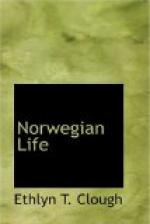The leading railway lines radiate from Christiania to Stockholm, Goteborg, Trondhjem, Gudbransdal, Telemarken, and the Valders. The longest line—three hundred and fifty miles—is from Christiania to Trondhjem through Hamar. There is also a relatively long line—one hundred and ninety miles—from Christiania up the Gudbrandsdal by Lake Mjosen and through Lillehammer to Otta. In 1906, the Valders railway, connecting Christiania with Fagernaes—a distance of one hundred and thirty-one miles—was opened. This connects with the most important of the new roads being built, the one from Christiania to Bergen. This road will reach entirely across the country, from Christiania on the Swedish frontier to Bergen on the Atlantic coast, thus making connection between the two largest cities of Norway, journeys between which are now only possible by steamships and carriages, consuming from three to six days.
The new road goes through the mountains and presents many engineering difficulties. Two-thirds of the way the roadbed must be cut out of the mountain side, and there is a tunnel three miles long at a height of two thousand eight hundred and twenty feet above the sea level. The snow in the winter is so heavy that it will be necessary to cover the tracks with sheds for a distance of nearly sixty miles. The construction is not only difficult, but expensive, and although the distance is but three hundred and ten miles, it will be one of the most costly railroads ever built. Sixty-seven miles of the line between Bergen and Vose, on the western coast, is already in operation, and it is a favorite journey of tourists, for the scenery is superb, although the traveler is in a tunnel one-tenth of the entire distance. There are forty-eight tunnels in all. A shelf has been hewn and blasted along the side of the mountains that encloses the celebrated Sorfjord.
The Norwegians call a railway a jernbane, literally “an iron path.” Their cars are made on the conventional European pattern, and are light and comfortable. They are furnished with toilet rooms, and run smoothly and noiselessly. Most of the trains are equipped with Westinghouse brakes, steam heat, and electric lights. The trains run very slowly. Economy is studied in this respect, as in every other. There is a certain speed—say, fifteen or eighteen miles an hour—which can be maintained at a minimum consumption of fuel, and the Scandinavian railway managers have figured it down to a dot. They can haul a longer train a greater distance with a ton of coal than any other engineers, and the most scrupulous attention is applied to every feature of management, the tracks, the rolling stock, the station, the crossings. The crossing-keepers are usually women. A large number of that sex are employed by the railways.




